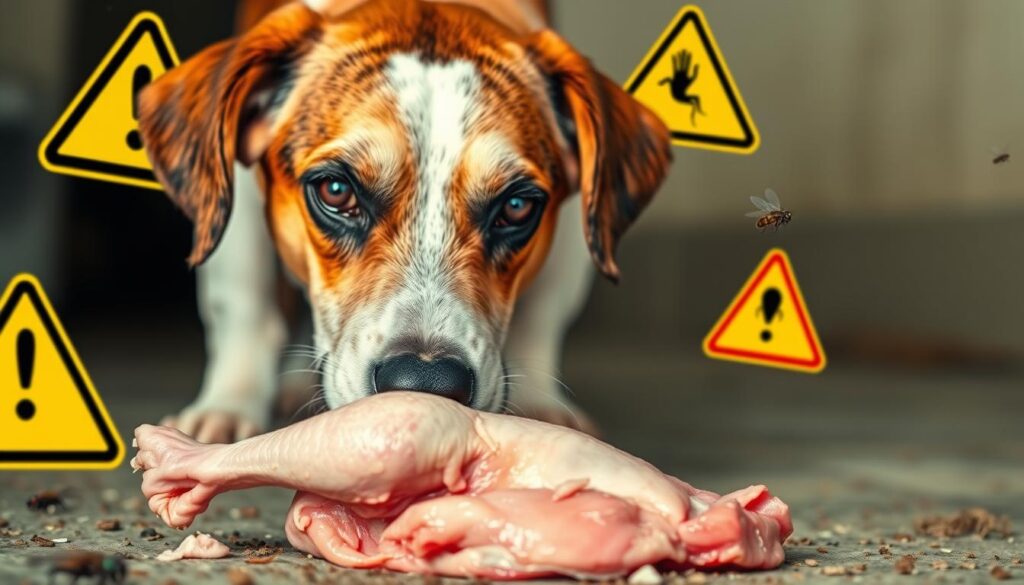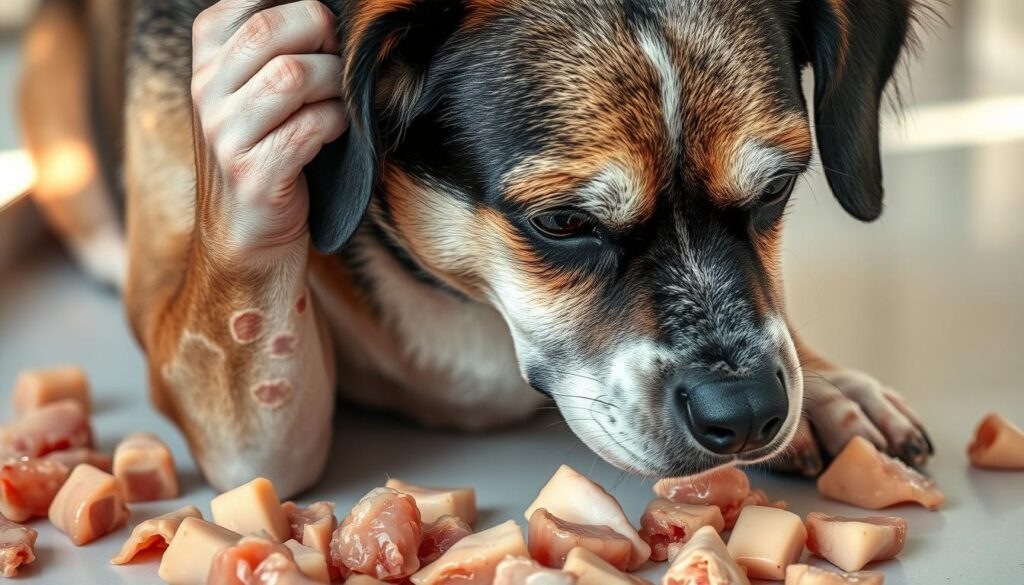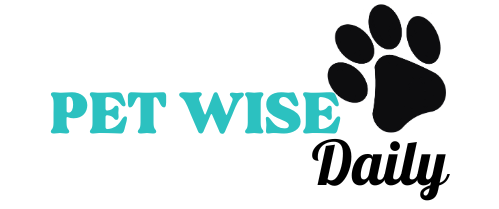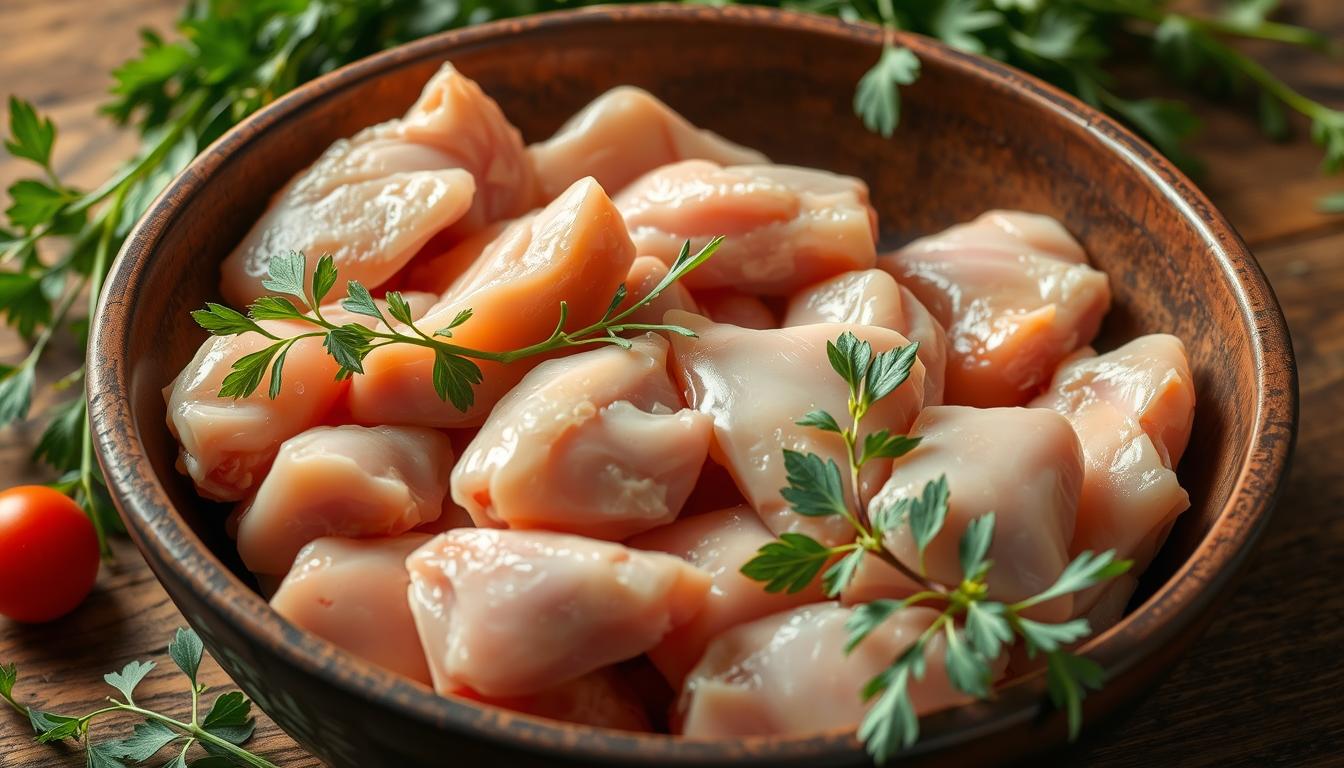As a devoted dog parent, you want the best for your furry friend. You might wonder if raw chicken is safe for them. The answer is not simple, and it’s important to be careful.
Raw chicken is a hot topic among pet owners and vets. Some say it’s natural and full of good stuff like protein and vitamins. But, there’s a big risk of harmful bacteria like Salmonella and Campylobacter.
You want to make the best choices for your dog. We’ll look into the good and bad of raw chicken. This way, you can make a choice that keeps your dog healthy and happy.
Table of Contents
Understanding Raw Chicken in Dogs’ Diet
Dogs have changed a lot since they were wild predators. Their diet needs have changed too. Some think dogs can digest raw meat better than humans, but vets disagree.
The Evolution of Dog Diets
Dogs come from wolves and have natural instincts for raw meat. In the wild, wolves ate raw meat, organs, and bones. This diet helped them stay healthy.
Natural Predator Instincts vs. Modern Domestication
When dogs became pets, their food changed to kibble. Some wonder if a raw canine raw food diet is still good for them.
Current Veterinary Perspectives
The raw food trend for dogs is growing. Some vets think a raw chicken diet for dogs can help with weight and allergies. But others worry about Salmonella, Campylobacter, and Clostridium perfringens. There’s not enough research on dogs and raw chicken diets.
| Potential Benefits of Raw Chicken Diet | Potential Risks of Raw Chicken Diet |
|---|---|
|
|
Nutritional Benefits of Raw Chicken for Dogs
Raw chicken is a great food for dogs. It has high-quality protein, amino acids, and essential fatty acids. These are key for your dog’s health and happiness. It also has niacin (vitamin B3), selenium, potassium, phosphorus, and magnesium. These nutrients help with digestion, muscle health, and more.
Chicken thighs and drumsticks are especially good. They have iron, riboflavin, zinc, and vitamin B12. Many dogs on a raw chicken diet look better. They have more muscle, more energy, and better skin and teeth.
| Nutrient | Benefits for Dogs |
|---|---|
| Protein | Supports muscle development and maintenance |
| Amino Acids | Essential for growth, repair, and optimal bodily functions |
| Omega-6 Fatty Acids | Promote healthy skin and a shiny coat |
| Niacin (Vitamin B3) | Supports digestive health |
| Selenium | Crucial for thyroid function and immune system |
| Potassium | Maintains muscle and heart health |
| Phosphorus | Supports bone health and cell production |
| Magnesium | Bolsters immune function |
Adding raw chicken to your dog’s diet is a good choice. It’s full of nutrients that dogs need. But, make sure to handle and store raw chicken safely to avoid bacteria.
Can Dogs Have Raw Chicken: Expert Guidelines
Feeding raw chicken to dogs must be done with safety in mind. It’s important to follow expert advice and think about different factors.
Safety Considerations for Raw Feeding
Raw chicken can have harmful bacteria like Salmonella and E. coli. These can be dangerous for your dog. Buy raw chicken from trusted farms that test for bacteria. Always thaw it in the fridge and use it in 3-5 days.
Remove bones and excess skin before giving it to your dog. These can be harmful if swallowed.
Portion Size Recommendations
- Extra-small breeds: 1 tablespoon of raw chicken
- Small breeds: 2 tablespoons of raw chicken
- Medium breeds: 1/4 cup of raw chicken
- Large breeds: 1/3 cup of raw chicken
- Extra-large breeds: 1/2 cup of raw chicken
These are general guidelines. Always check with your vet to make sure your dog gets the right amount of raw chicken.
Signs of Chicken Tolerance
Watch for signs your dog can handle raw chicken. Look for normal digestion, energy, and health. If your dog has vomiting, diarrhea, or skin issues, stop raw chicken and see your vet.
Always put your dog’s safety first when thinking about a raw chicken diet. Follow these guidelines and talk to your vet. This way, your dog can enjoy raw chicken safely.
Potential Risks and Health Concerns
Feeding raw chicken to your dog might seem tempting. But, it’s important to know the risks and health concerns involved. The main danger is getting sick from harmful bacteria like Salmonella or Campylobacter. These can cause food poisoning in dogs, leading to vomiting, diarrhea, fever, and feeling very tired.
Raw meat can also have parasites and antibiotic-resistant bacteria. These can be very dangerous for your dog. Another big risk is chicken bones breaking and causing choking or holes in the stomach or intestines. This can be very serious and even life-threatening.
- Chicken is a common allergen for dogs, and eating too much can cause problems.
- Puppies are more at risk because their immune systems are still growing. They can get very sick from raw chicken.
- Eating too much chicken skin can also cause obesity and pancreatitis in dogs.

When thinking about giving raw chicken to your dog, consider the risks and health concerns carefully. It’s best to talk to your vet to make sure your dog stays safe and healthy.
Raw vs. Cooked Chicken: Making the Right Choice
Feeding your dog chicken can be a debate. You might choose raw or cooked chicken. It depends on how you feel about cooking and what’s best for your dog’s health.
Comparing Nutritional Values
Chicken’s nutritional value doesn’t change much when it’s cooked right. It’s low in fat and high in protein, which is good for dogs. Some say raw chicken keeps more natural enzymes and nutrients than cooked chicken.
Processing Methods Impact
Cooking chicken kills harmful bacteria like Salmonella and Campylobacter. This makes it safer for dogs. But, raw chicken can still be risky. When cooking chicken for your dog, don’t add seasonings and remove bones to avoid choking hazards.
Safety Differences
Raw and cooked chicken can both be safe for dogs. Your choice depends on your comfort with cooking and your dog’s health. Talk to your vet or a pet nutritionist to find the best diet for your dog.
Choosing between raw and cooked chicken for your dog is important. Understand the raw vs cooked chicken for dogs and chicken preparation for dogs well. This way, you can make a choice that’s best for your dog’s health.
Signs of Chicken Allergies in Dogs
Chicken is a common allergen for dogs. If your dog shows signs of a chicken allergy, act fast. Symptoms include itching, hives, trouble breathing, and indigestion. Other signs are ear infections, gas, vomiting, and obsessive licking.
Some dog breeds, like Bulldogs and Retrievers, are more likely to have chicken allergies. A 1-3 month elimination diet can help diagnose the allergy. Blood and skin tests can also help, but they’re not always accurate.
If your dog is allergic to chicken, there are other protein sources like salmon and beef. Chicken fat is usually okay for dogs with chicken allergies. Most dogs can also eat eggs without problems.
Allergies in dogs can’t be cured, but their symptoms can be managed. By changing your dog’s diet and getting vet advice, you can improve their life. This way, your dog can live comfortably and healthily.
| Symptom | Description |
|---|---|
| Itching | Intense, persistent scratching or licking of the skin |
| Hives | Red, raised bumps or welts on the skin |
| Trouble Breathing | Difficulty inhaling and exhaling, potentially due to swelling |
| Indigestion | Bloating, gas, vomiting, or diarrhea |
| Ear Infections | Recurring or chronic ear inflammation and irritation |
| Skin Infections | Rashes, hot spots, or other skin lesions |

Safe Handling and Storage Practices
Feeding raw chicken to your dog needs careful storage and prep. Knowing how to store and prepare raw chicken for dogs helps avoid bacterial risks. This ensures your dog stays safe and healthy.
Proper Storage Guidelines
Keep raw chicken fresh and safe by storing it in the fridge at 40°F (4.4°C) or lower. Use it within 3-5 days. For longer storage, freeze it at 0°F (-18°C) or lower.
When thawing frozen raw chicken, do it in the fridge. Avoid thawing at room temperature to stop harmful bacteria growth.
Preparation Best Practices
When preparing raw chicken for dogs, keep everything clean. Use separate boards, utensils, and bowls for the raw chicken. This prevents cross-contamination.
Wash your hands with soap and water for 20 seconds before and after handling the raw chicken. Clean and disinfect all surfaces that touch the raw chicken to avoid bacterial spread.
Cross-contamination Prevention
To avoid cross-contamination, keep raw chicken separate from other foods. Store it in dedicated containers or on the bottom shelf of the fridge. This prevents drips or spills from contaminating other foods.
Follow safe food handling practices. Wash cutting boards and utensils well after use. This minimizes bacterial transfer to your pet or family.
By following these safe handling and storage practices for raw chicken, you can give your dog the benefits of a raw chicken diet. This way, you ensure their health and safety.
Transitioning to Raw Chicken Diet
When you start adding raw chicken to your dog’s diet, do it slowly. Mix a little raw chicken with their usual food at first. Then, gradually add more over 1-2 weeks. Watch how your dog reacts and adjust as needed.
Before switching to a raw chicken diet, talk to a vet or a canine nutritionist. They can make sure your dog gets all the nutrients they need. You might also need to add other foods to make sure your dog’s diet is complete.
Keep an eye on your dog during the transition. Look out for any signs of upset stomach or allergies. Be patient and go slow. With the right help, your dog can get used to eating raw chicken.

